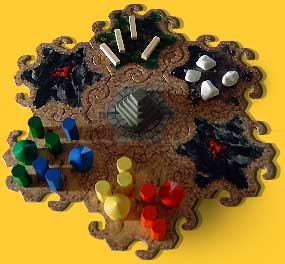Mesopotamia
Author: Klaus-Jürgen Wrede
Publisher: Phalanx Games
Year: 2005
review by

| x |
|
|
|
|
|
|
|
|
|
|
|
|
|
|
|
|
|
|
|
|
|
|
|
|
|
|
 |
Sometimes who or what we are is unimportant: we have a hut, a couple of walking about partisans, and elsewhere in Mesopotamia consisting of hexagonal tiles some stone and wood is to be found, the stone on a stone tile, the wood on a woods tile, scarcely enough for each of the two to four players. A temple is amidst the board where the players will bring their preset offerings during the course of the game. The most hard-working player who first succeeds to deliver all four of them has won the game.
What are the possibilities in a turn? A player can move, not moving does not give us any progress, and we wouldn’t get anywhere. After moving we may choose any one from a number of actions and perform it multiple times: build a hut, erect a holy place, population growth, and ‘take a card’. As an exception, this last action may only be performed once. |
| x |
|
|
|
|
|
|
|
|
|
|
|
|
|
|
|
|
|
|
|
|
|
|
|
|
|
|
Our tribe, little of scope, has 5 movement points per turn to divide between their partisans as they see fit. During movement certain tasks can be performed. In this way, wood can be transported to a plains tile to build new huts there with a maximum of two huts per tile, if a player meets the condition of having two partisans of his colour together with a woods stick on or transported to that plains tile. When there is no such space left or if he just feels like it, a player can decide to discover new land; he draws up to three tiles from a blind stack. Any vulcano tiles can be put anywhere adjacent to existing tiles; they hinder movement, preferably the other players! For every volcano tile, a new tile may be drawn. ‘Normal’ tiles like woods or plains must be placed at the edge where the discovery is made. Also a player may participate in the construction of the temple by moving stones to it.
Because it is just like the real world, a player may steal a woods or stone from an other player who is carrying this resource, if he does this with a cowardly majority of partisans at the spot where the loot is transported. But in the end all is about the offerings to the temple. |
 |
| x |
|
|
|
|
|
|
|
|
|
|
|
|
|
|
|
|
|
|
|
|
|
|
|
|
|
|
 |
These offerings are of varying size and are depicted on little round coins; a ‘2’ is an offering of nuts, where a ‘7’ is a major offering of a goat. But players will only look at the numbers on these coins as this is the minimum amount of manna they will have to collect on their manna scale before being allowed to bring that specific offering to the temple. Manna, come again? For the ignorant of the stories of the Old Testament among us, we cite Exodus: |
| x |
| 13In the evening quail came up and covered the camp, and in the morning dew lay around the camp. 14And when the dew had gone up, there was on the face of the wilderness a fine, flake-like thing, fine as frost on the ground. 15When the people of Israel saw it, they said to one another, ‘What is it?’ For they did not know what it was. And Moses said to them, ‘It is the bread that the Lord has given you to eat.’ 31 The people of Israel called the bread manna. It was white like coriander seed and tasted like wafers made with honey. |
|
|
|
|
|
|
|
|
|
|
|
|
|
|
|
|
|
|
|
|
|
|
|
|
|
|
|
| We are however in Mesopotamia, not necessarily around the corner of meant (Sinai) desert, but close enough to allow this licentia poetica. The manna in the game does not come by itself, but we are able to manipulate the gods in a way. Each time we contribute to the building of the temple by delivering a stone to it, we get 1 manna. At the same time our allowed manna score is raised by 1, in this way slowly saving for enough manna for an offering and bring it to the temple. |
|
  |
| x |
|
|
   |
| x |
|
|
 |
 |
 |
| x |
|
|
 |
 |
|
|
|
|
|
|
|
|
|
|
|
|
|
|
|
|
|
|
|
|
|
|
|
|
|
|
|
|
|
|
|
|
|
|
|
|
|
|
|
|
|
|
|
|
|
|
|
|
|
|
|
|
|
|
|
|
|
|
|
|
|
|
|
|
|
|
|
|
|
|
|
|
|
|
|
|
|
|
|
|
|
|
|
|
|
|
|
|
|
|
|
|
|
|
|